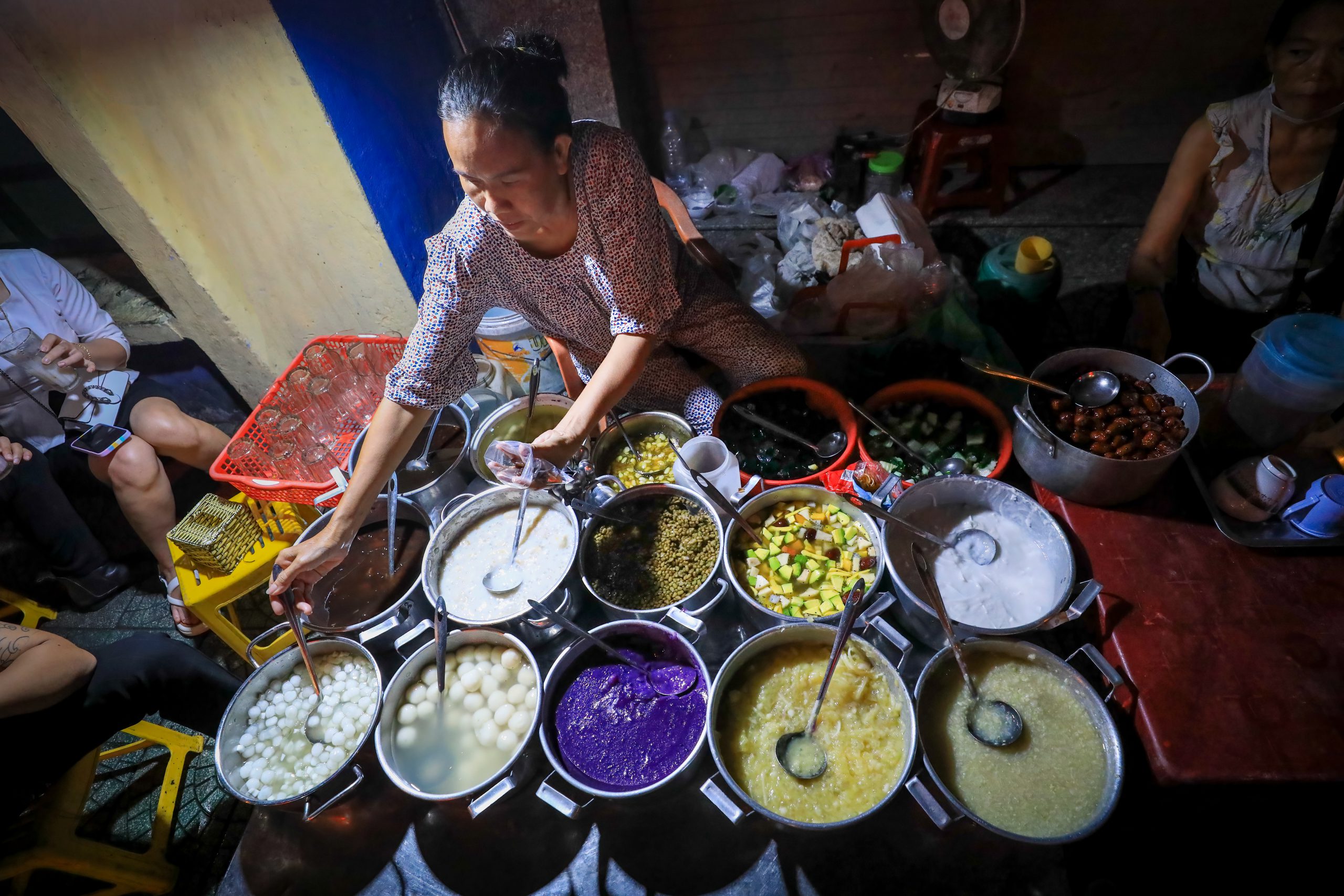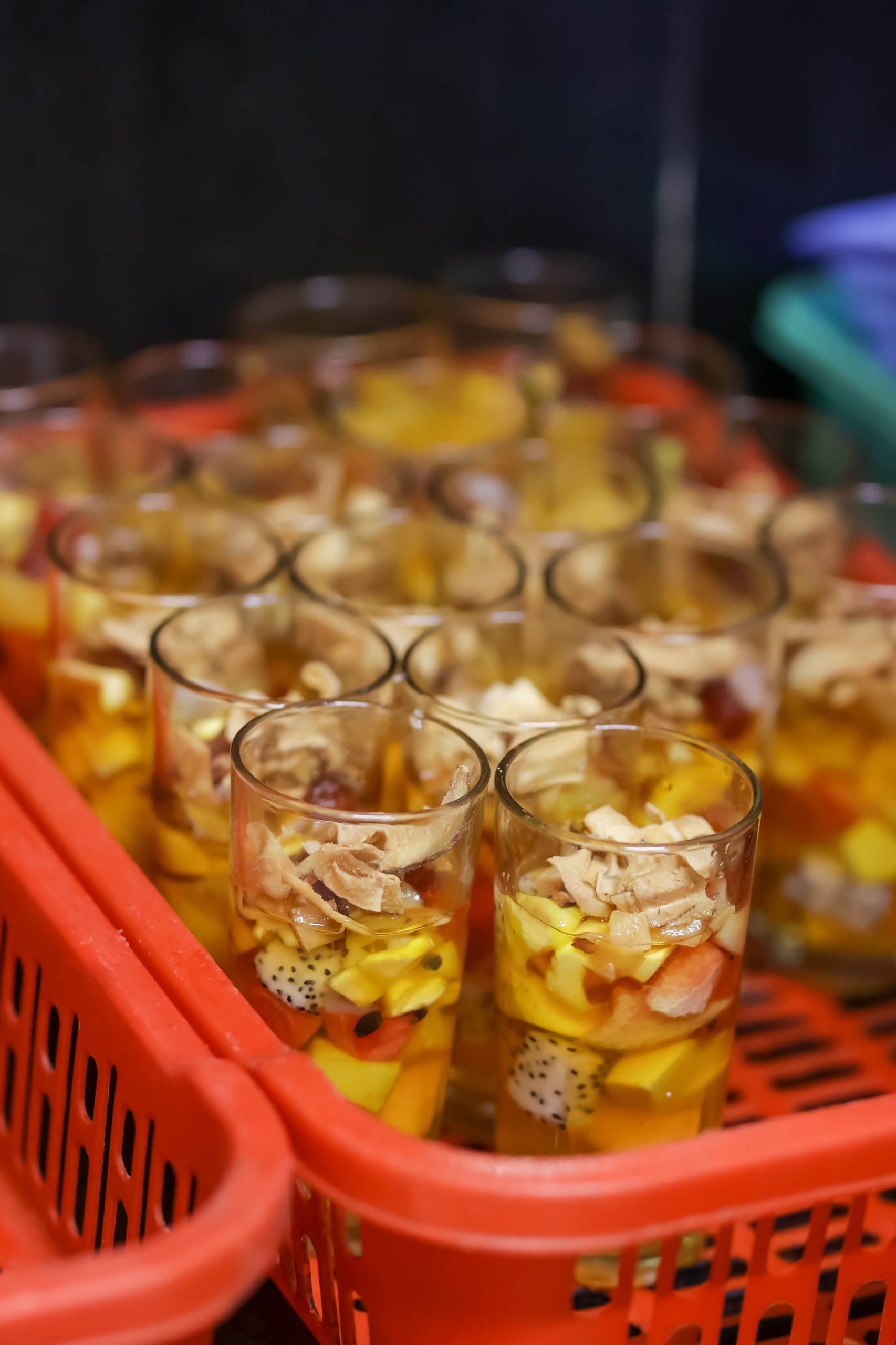Story: Nguyen Huu Chien Thang
Photos: Nguyen Phong
Wherever you go, you will find varieties of chè – a collective term for puddings and desserts served in syrup. So, what’s special about the chè in Hue? When you visit the former imperial city, sample some chè and you will understand why it’s famous.

The puddings and sweet soups found in Hue are very diverse. Across Vietnam, beans are traditionally used to create these comforting desserts – whether they feature black beans, mung beans, or other varieties. Hue has more options, including versions made with red beans, hyacinth beans, and kidney beans. Each hyacinth bean is pristinely white and submerged in the clear syrup. As for those made with red beans and kidney beans, they may look like plain beans at first glance, but add a bit of coconut milk and a spoonful of shaved ice, and you have an instantly delicious dessert with beans that are both tender and smooth. When peeled and whipped, the mung beans turn a lustrous golden color.
There is more to Hue’s chè than beans. In the morning, sweet syrup with lotus seeds is popular. The lotus seeds are not large but rich, aromatic, and full of earthy flavor. People here only sell plain lotus seeds in syrup. The dessert featuring lotus seeds wrapped in longans is not on offer. Hue families only prepare this dish for worship and eat it afterward. We might find it at the buffet of a large hotel, but in such luxurious places, the dishes tend to lose some of the flavor of the ancient capital.

Hue also has several types of puddings made with yams and potatoes. The most iconic and Hue-specific is chè made with purple taro, the color reminiscent of the violet hue of ao dai worn by girls at Dong Khanh High School. Other puddings are made with purple yams, and sweet corn, etc. Fruit like pomegranate seeds are mixed and soaked in sugar water, then added to shaved ice before serving. Sweets made using seasonal fruit may consist of dragon fruit, watermelon, pineapple, jackfruit, and whichever fruits are in season, each contributing their unique flavors to a colorful glass of Hue fruit chè. The sweetness of the sugar and the refreshing taste of fresh fruit go hand in hand, delivering a complete flavor experience.
Watching vendors bear loads of stacked servings as they roam through the imperial city, you can appreciate the abundance of sweets on offer. When they set down their load, they unveil a landscape of sweet and aromatic flavors. Stop by any chè stall, whether on a street or in an alley, and you will be dazzled by the menu. The chè stall right at Thuong Tu Gate pleases guests and satisfies the curiosity of those wishing to experience a variety of tastes. The vendor presents a flat winnowing basket of puddings. A glance reveals over a dozen types of desserts neatly arranged on a charming flat basket. The tray resembles a colorful painting, and it smells as fragrant as a bouquet of night-blooming flowers. Each type of chè is in a separate small bowl. There are only two full spoons per bowl, no more than that. If you are in a hurry, you can finish a bowl in a single slurp. But in Hue, who eats in such a rush? Savor the pudding slowly. After all, the essence of the Sacred Capital’s cuisine lies in quality, not quantity. After tasting an array of these tiny desserts, you’ll find that you’re full enough to skip a meal.
In Hue, behind the Imperial Citadel, lies a village named Doc So. The women of this village make their living as hawkers, bearing shoulder poles laden with snacks around town. Naturally, there are also generational street vendors selling traditional sweet soup, the recipes passed down from grandmother to mother to daughter. Every afternoon, these women gather at Tay Loc Market. They engage in lively chatter, sharing tales and laughter after a long day of crossing the city of Hue with their heavy loads. Joys and sorrows inevitably revolve around the subject of their day’s trade. Life for these vendors stretches out across roads traversed a thousand times, upon shoulders that have tirelessly borne the weight of rain and sun.
Once, on a sunlit afternoon, I sat by the roadside on Le Duan Street, where flamboyant flowers leave the road awash with red, savoring a bowl of chè and pondering an overheard conversation:
“Why did you waste it?”
“Because it’s too sweet.”
“If it’s too sweet, ask me to add more ice. Making a bowl of chè takes a lot of effort, from planting the beans to the sugarcane. Wasting it like that disrespects their hard work, my child!”
My bowl of chè seemed to weigh heavily on that golden summer afternoon in Hue.










